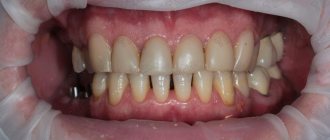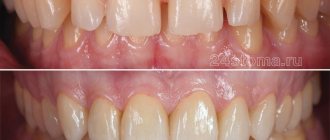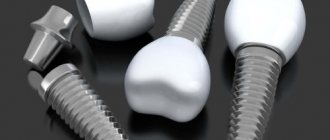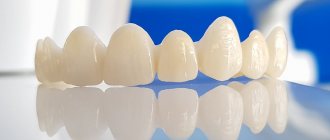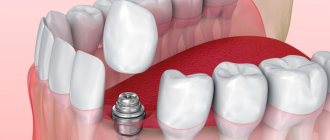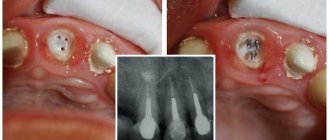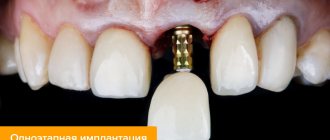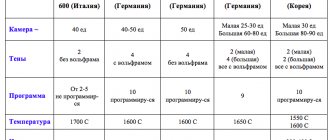Dental implantology began to develop after titanium was discovered to fuse with bone. Until now, most artificial roots are made from this metal, but worthy alternatives already exist and are being successfully used. To quickly restore the functionality and aesthetics of teeth at the German Implant Center, patients can install high-strength zirconium implants on a turnkey basis. These structures are more expensive than titanium products, but is there any point in overpaying and what is the difference between modern implantation systems? The chief physician of the clinic, Dakhkilgov Magomed Umatgireevich, answers these questions.
PREMIUM DENTAL IMPLANTATION WITH ZIRCONIUM IMPLANTS BREDENT (GERMANY)
Zirconium implants are a modern development of European dental research centers in the field of safe dental implantation.
DENTAL CLINIC "BIONIC DENTIS" IS THE ONLY OFFICIAL CENTER FOR INSTALLING ZIRCONIUM IMPLANTS OF THE GERMAN MANUFACTURER BREDENT IN THE TERRITORY OF THE RF AND CIS COUNTRIES.
Our clinic, like many premium clinics in Europe and the USA, uses the method of installing zirconium implants.
We were the first in Russia to begin installing these structures and have accumulated extensive clinical experience, which helps us solve the most difficult problems that patients pose to us.
Zirconium implants No. 1 in the European I&O EU20 ranking
CLINICAL EXAMPLE OF ZIRCONIUM IMPLANT INSTALLATION
IN THE PHOTO: Clinical situation of edentulous lateral chewing tooth. The bone size was measured using the image.
IN THE PHOTO: Formation of the hole for the implant and the appearance of the zirconium implant
IN THE PHOTO: Installed implant and the situation after 2 weeks.
IN THE PHOTO: The crown on the implant and the x-ray show good quality and high aesthetics.
According to research by the European Osseointegration Association, 26 percent of patients have an allergic reaction to titanium, from which 98 percent of all dental implants used in the world are made.
Intolerance to titanium implants leads to the following consequences:
- implant rejection
- inflammation of bone tissue in the area of installed titanium implants
- inflammation of the gum tissue in the area of the installed implant
- discharge of pus from the gums
This clinical picture indicates rejection of the installed titanium implant and the need to remove it.
Special categories of patients have been identified who need to be especially careful when installing a titanium implant.
Patients in this category include:
- polyallergosis
- psoriasis
- hay fever
- allergy to metals
- multiple allergic reactions
These patients, before installing dental implants, must undergo laboratory tests - the Titanium Tolerance Test, which will show with 99 percent accuracy whether it is possible to safely install titanium implants or not.
If it is not possible to install titanium implants, then do not despair.
Modern dentistry includes zirconium implants in its range of methods. Such implants are the most technologically advanced of all systems on the market. They solve many of the problems with titanium implants that doctors and patients encounter.
Cons and contraindications
Of course, this option also has disadvantages and contraindications, although in very small quantities. So, the only disadvantages include:
- high cost;
- insufficient knowledge of the technology.
Regarding contraindications, it should be said that these products cannot be used for:
- bruxism;
- pregnancy;
- deep bite
In all other cases, there are no obstacles or barriers to placing zirconium crowns on implants.
ZIRCONIUM IMPLANTS STRUCTURE FEATURES
The shape of a dental implant, the type and type of thread on it is called implant architecture. These zirconium structures have several distinctive features
- implants are monolithic, which means that the implant and abutment, which usually come separately, are combined into one structure with these implants.
- the threads on the implants have sharp edges, which allows them to effectively “bite” into the bone tissue and firmly fix themselves in it immediately after installation.
- This implant has the possibility of customization, which means that the dentist can change the shape and length of the implant in the abutment area. This feature allows you to ideally adjust the implant to the individual conditions of the oral cavity of each patient.
- The neck of the implant has a special shape; it has a cushion to which the gum tissue fits tightly, preventing bacteria from penetrating the bone and causing peri-implantitis. Additionally, this feature allows you to avoid gum inflammation and recession.
IN THE PHOTO: Implantation process
IN THE PHOTO: Installed implants
Installation process
The process of installing zirconium implants is, as usual, a sequence of actions:
- Consultation and anamnesis. At this stage, the patient and doctor are fully informed about their joint matter. Here it is very important to collect the maximum amount of information about the patient’s health characteristics. During this stage, possible contraindications to the procedure are assessed. The doctor carefully examines the patient’s oral cavity and draws conclusions about the type of implant that will be installed there. In addition, the doctor must consult with the patient and discuss any questions that may arise regarding the procedure and other subtleties.
- Secondary appointment, x-ray, cleaning. This stage is necessary to obtain information about which teeth will need to be treated before installing zirconium implants. Next, the doctor sends the patient for professional oral cleaning. This is a necessary procedure in which all unnecessary deposits are removed. Their presence will certainly lead to undesirable complications during surgery.
- Anesthesia. The implant is installed under anesthesia performed by an anesthesiologist. The responsibilities of the anesthesiologist include determining the patient's contraindications to anesthesia. If they are detected, doctors will not perform surgery. The implant is implanted under local anesthesia. It is very important to determine the dosage correctly. The dose of the administered medication depends on the gender, height, age and weight of the patient.
- Implantation procedure. Initially, the doctor cuts the gum and opens a passage to the bone tissue. After this, drilling of this tissue begins. It is very important here that the diameter of the drill is slightly smaller than the diameter of the implant itself. This will allow the pin to be firmly and securely fixed in the bone tissue. The grooves on the product also contribute to this. It is important to treat the bone tissue and the drilled hole in it with an antiseptic. An implant is inserted into the drilled hole. The edges of the cut gums are sutured. To stop minor bleeding, a cotton swab is placed in the patient's mouth.
Possible complications
The design itself and the procedure for its implantation can cause some complications. Since the material has been little studied, a small risk of danger after surgery remains.
Mistakes made during surgery will undoubtedly lead to subsequent complications after it. In this case, serious health problems are guaranteed. Typically, incorrect installation causes the following symptoms: headache, fever, toothache.
The implant healing stage lasts a very long time: 4 months (lower jaw) and 6 months (upper jaw). During these periods, teeth hurt and ache.
The entire postoperative and rehabilitation period must be strictly visited by a dentist. He will monitor the healing process. This is usually already included in the cost of installing the implant and crown.
It is almost impossible to remove a previously installed implant. It is so implanted into the bone tissue that it becomes part of it.
ZIRCONIUM IMPLANTS INDICATIONS FOR INSTALLATION
The main indications for installation of zirconium implants are as follows:
- missing one tooth in the anterior jaw
- missing several teeth in the anterior jaw
- missing one tooth in the lateral jaw
- missing several teeth in the lateral jaw
- a “loose” tooth, in this situation the tooth is removed, and a zirconium implant is immediately installed in the hole in the bone where it was located.
- tooth fracture; in this situation, the implant is inserted into the bone in place of the unusable tooth immediately after its removal.
- a crack in the root of the tooth, in which case the cracked root is replaced with an implant.
- allergic reaction to titanium implants
- intolerance, lack of tolerance to titanium
- the need to install implants in patients with psoriasis
- the need to install implants for people with polyallergosis.
In Russia, doctors and patients have a misunderstanding about the indications for installing zirconium implants; such implants are recommended only for “problem” patients with an allergy to titanium or after the patient experiences rejection of previously installed titanium implants.
However, European dental practice shows otherwise: zirconium implants are the method of choice for any clinical situations requiring dental implantation.
Zirconium implants are most often used in Europe and the USA in premium dental clinics, as they are the most well-proven implants and bring stable clinical results.
Postoperative period
During the period after the operation, the patient is prescribed antibiotics and painkillers; usually, visits to the doctor are scheduled for the first month after the operation, then the third and seventh, but at the slightest symptoms of deterioration in health, it is necessary to visit the doctor outside of this schedule so that you can respond to any problems in a timely manner. other processes in the body.
Even during this period, the importance of proper dental care increases more than ever; all hygiene procedures must be performed carefully, but carefully, to prevent damage to the prosthesis. You should remove solid foods from your diet for a while, but this restriction will not be long-lasting; a couple of weeks will be enough. In any case, you should regularly visit your doctor and strictly follow all recommendations prescribed by him.
ZIRCONIUM IMPLANTS, ADVANTAGES OF USE
In clinical practice in dental implantation, doctors encounter some problems that sometimes do not allow them to achieve high results in the rehabilitation of patients with partial and complete loss of teeth.
European research centers have been constantly working to improve the materials and structure of dental implants.
One of the most important achievements in modern medicine is the creation of zirconium implants.
Problems faced by implantologists and their patients solved thanks to the use of zirconium implants:
- An allergic reaction to titanium was found in 26 percent of patients. It is clinically proven and diagnosed using the Titanium Tolerance Test. Previously, such patients were denied implantation, but with the use of medical zirconium for the manufacture of implants, this problem was completely solved. An allergic reaction to zirconium has not yet been recorded in more than one patient.
- contamination of the internal space of the implant. Inside the implant there is a small recess in which a thread is cut. Due to this thread, an abutment is attached to the implant. However, multiple studies have shown that the internal cavity in the implant is always infected and is an excellent space for the reproduction and growth of pathogenic bacteria, which lead to implant rejection. Zirconium implants are monolithic, that is, the implant and abutment are manufactured from one block of zirconium. Thanks to this manufacturing method, there is no cavity in the implant, which means there is no colony of bacteria and no possibility of inflammation.
- poor stability of the implant-abutment connection. In titanium implants, the abutment and implant are 2 separate structures that are connected by a screw. When chewing movements in the oral cavity, the screw is constantly under stress or overload. Over time, the screw weakens the fixation of the abutment to the implant and the connection becomes loose. As a result, the crown falls off the implant. A frequent complication in prosthetics on implants is a fracture of the fixation pin; under high load, the screw fixing the abutment to the implant breaks into 2 parts. The lower part jams in the implant, blocking the thread. In 85 percent of cases, such a screw fragment cannot be removed and the implant has to be removed and a new one installed. This results in financial costs and stress for the patient. Due to the fact that the zirconium implant is a monolithic implant/abutment structure, it has a reinforcement zone in the place where it experiences overload. The monolithic structure is 800 percent stronger than screw-fastened parts, providing unsurpassed strength and durability.
- violation of the aesthetics of soft tissues due to the transillumination of a dark implant. This implant is dark gray in color. In cases where the patient has thin gum tissue, such an implant will be visible through it and will affect the aesthetics. The zirconium implant is white, it is not translucent and looks perfect in the oral cavity.
- the problem of gum recession and implant exposure. Over time, the bone tissue of a titanium or zirconium implant begins to settle. However, the implant is firmly anchored in the bone. In the case of a titanium implant, if such a problem occurs, the implant should be removed and replaced with a new one. In the case of a zirconium implant, this problem is simply solved without removing the implant. It is enough to grind off the threads on the protruding part of the implant and polish it. After which only a new crown is installed, and the implant continues to serve for many, many years.
- the problem of penetration of microbes due to the lack of connection between the gum and the neck of the implant. An important feature of your own tooth is that the gum tissue adheres to its neck, preventing the penetration of mircobs from the oral cavity directly to the jaw bone. When a tooth is lost and a titanium implant is installed, tissue tissue cannot stick to the metal neck of the implant, and microbes pass under the gum without hindrance. In the case of zirconium implants, the connection between the gum and the zirconium neck is much tighter. Of course, it is inferior in strength to the connection between the gum and the neck of a natural tooth, but it is many times superior to such a connection between the gum and metal. Thanks to the use of zirconium in implantation, the patient’s gums look healthy and indistinguishable from the gums of their own teeth.
BIO CONCEPT OF IMPLANTATION IS A WORLD TREND
Biological dental implantation is an internationally recognized trend:
- We do not injure the patient’s own tissues
- We do not introduce foreign metal implants
- We follow natural principles of prosthetics and implantation
Features of zirconium implants
STARTSMILE: What are zirconium implants made of and what do they look like?
Dakhkilgov Magomed Umatgireevich:
German zirconium implants from Bredent, with which we work, are made of stabilized zirconium dioxide. Most acids do not affect this material, that is, the stability is quite high. Plus, excellent biocompatibility is a very important indicator for patients. Metal-free implants do not distort tastes and do not irritate mucous membranes. This, by the way, differs zirconium dioxide from titanium. In its pure form, this metal is not suitable for making implants, as it is too soft. Titanium alloys are used to restore teeth, but some of them cause an immune response. Zirconium is completely hypoallergenic. In addition, zirconium systems are completely white and are ideal for an aesthetically significant area or the smile area, as patients like to say. When exposed to light, the titanium implant body may be visible. Products made from zirconium have a light shade; no darkening will be visible.
STARTSMILE: It turns out that patients have no questions or complaints about aesthetics. What about the durability? Titanium has already proven its reliability; won’t metal-free systems disappoint their owners?
Dakhkilgov M. U:
Zirconium implants are monolithic, that is, the abutment and the body itself are a single structure. Such know-how in product architecture did not appear by chance. The fact is that for a long time there was a problem with fixing zirconium artificial roots. The most vulnerable part was precisely the connection between the body and the abutment, and the zirconium connecting screw has a certain fragility. If the fixation is weakened due to chewing loads, the crown may fall off or, for example, the screw itself may break. Usually, in such cases, the implant must be replaced with a new one, which means additional expenses for the patient, time, stress, etc. By the way, a similar problem exists in titanium implants, but there it is less noticeable, since titanium itself is more elastic.
Dakhkilgov M. U:
With the introduction of the SKY solid zirconia systems from Bredent, the problem of joint instability has been solved. A unique type of thread appeared, as well as heterogeneity in the body of the implant itself. Now the upper part, which is above the gum, can be prepared like your own tooth, it accepts it very well.
STARTSMILE:When did zirconium implants appear and how quickly did they establish themselves on the market?
Dakhkilgov M. U:
By implantation standards, these systems appeared not so long ago. They have existed for more than 10 years, and today about 5-6 companies of zirconium implants from the USA and European countries are already known. We work mainly with German brands. In particular, we cooperate directly with Bredent Medical. All implants that are installed in our clinics are certified, reliable, and time-tested.
STARTSMILE: So far everything is convincing and tempting, but there are also disadvantages? Tell us about them.
Dakhkilgov M. U:
The only negative is the price. Due to the more complex manufacturing and installation technology, the cost of zirconium implants is higher than that of titanium structures, but if the patient is looking for the highest quality and most reliable systems for dental restoration, we recommend zirconium ones. Nothing better has yet been invented.
ZIRCONIUM IMPLANTS CONTRAINDICATIONS FOR USE
There are few contraindications for the use of zirconium implants:
- oncological diseases of the jaw bone
- use of pure bisphosphonate drugs
- diabetes mellitus in an uncompensated state with a sugar level above 10.
- Stage III osteoporosis.
- osteomyelitis of the jaw
- periostitis of the jaw
- mental illness
IN THE PHOTO: Correspondence between the shape of the root of your own tooth and the shape of the zirconium implant.
INSTALLATION OF A ZIRCONIUM IMPLANT IN A PATIENT WITH AN ALLERGY TO TITANIUM
We bring to your attention a complex clinical case of rehabilitation of a patient using zirconium prostheses.
Patient Tatyana Dmitrievna contacted the Bionic Dentis dental clinic with the need to install dental implants in place of lost teeth.
A concomitant problem of the patient was an allergy to metal.
We conducted a Titanium Tolerance Test, which showed a high level of allergic reaction to titanium implants and the impossibility of using metal implants.
It was decided to install a BREDENT zirconium implant.
The patient underwent implantation surgery and installation of a zirconium dioxide crown.
An excellent result was obtained.
There is no implant rejection.
Clinical effect 10 out of 10;
What didn't you like about titanium?
Traditionally, artificial dental roots - implants - are made from titanium alloys. Titanium itself is a biocompatible material. However, to give the products greater strength, other metals are added to it. These are the ones that cause irritation of the oral tissues in some patients. In addition, many patients are concerned that titanium implants will show through the gums in bright light.
5 features of zirconium dioxide:
- biocompatible, suitable for all patients;
- white, easily tinted to a flesh color, so it does not show through the gums;
- does not affect the taste of food;
- strength comparable to light grades of steel;
- Suitable for implantation in any area of the oral cavity.
MANUFACTURERS OF ZIRCONIUM IMPLANTS
The global dental market is quite extensive. Several well-known implant manufacturers have begun making them from zirconium.
Currently, the following types of zirconium implants are known in the world:
- Nobel Bioker
- Straumann
- Bredent.
The German company BREDENT is a leader in the development of innovative products in dentistry. High German quality and modern developments in dentistry make this implant unsurpassed among its analogues.
The only zirconium implants approved for use in the Russian Federation are BREDENT implants. They successfully passed clinical trials and received a registration certificate from Roszdravnadzor.
While obtaining permission for use in Russia, BREDENT implants underwent the most stringent toxicological and clinical tests, which showed that these implants are ideal for eliminating dental defects in any clinical cases.
Which abutment should you choose?
An abutment is a structure necessary for installing a zirconium crown on an implant. Functionally, it is similar to a stump pad and acts as a kind of connecting link between the prosthesis and the artificially created root. Without a correctly selected and installed abutment, there is simply no way to talk about a high-quality implant and prosthetics.
It is best to use a zirconium abutment; this option is good from both a functional and an aesthetic point of view, but if the latter factor does not play a decisive role, then it is quite possible to get by with a metal abutment, although in this case you need to be prepared for the fact that it will be noticeable under the crown.
Abutments can be manufactured either factory-made or individually. The latter were very expensive until recently, but the development of computer technology has made it possible to make them more accessible. In their shape, these products are very similar to a tooth ground for installation of a crown and are an excellent anatomical solution, since they do not allow the cementing solution to pass under the gum and prevent the occurrence of inflammatory processes in it.
HOW TO PLACE ZIRCONIUM IMPLANTS
Zirconium implants require special installation techniques. Unfortunately, in Moscow, only 2-3 clinics have the conditions for installing zirconium implants. The qualifications of the implant surgeon who performs the operation are also important.
Let us consider the features of installing zirconium implants in patients with partial loss of teeth.
- Before implantation, the patient is prescribed laboratory blood tests, which include: a clinical blood test, a biochemical blood test, and the determination of certain infections. This is necessary so that the doctor sees that the state of health allows the operation to be performed and implant rejection will not occur.
- To plan implantation and accurately select the size of the implant, the patient undergoes a computed tomography scan. Tomography examines the density of bone tissue, determines the optimal position of the implant in relation to neighboring teeth, blood vessels, nerves, and sinuses of the jaw.
- A special feature of installing a zirconium implant is that the implant must be ideally installed correctly, its inclination must be taken into account, and its position inside the crown must be taken into account. Such precision installation cannot be done by eye. Navigation systems are used for correct positioning. The implantologist uses a computed tomography scan using modern computer programs to select the ideal place to insert the implant into the bone. At the same time, he sees in the program how the implant will relate to any of the crowns he has chosen. After determining the implantation site, a navigational implant template is made on a No. D printer. This template is used during surgery to make a hole for the implant in the correct place. Thanks to this method, implantation does not take much time, and the implantologist and patient receive the ideal position of the implant and the highest quality prosthetics.
- A hole is prepared in the bone into which the implant will be screwed. The hole is made using calibrated cutters, with constant cooling with sterile saline solution. This technique eliminates overheating of the bone and the appearance of unpleasant sensations during surgery and bone burns. The implant is screwed into the bone using a computerized system that calculates the stress in the bone during implant placement and prevents compression of the bone tissue, which can negatively affect the results of the implantation.
- After installing the implant, a pair of sutures are placed on the gum to ensure its adherence to the neck of the implant.
- An important feature of BREDENT zirconium implants is that the doctor has the ability to adjust its height. All patients are different, and the height of the teeth is different for everyone; it cannot be calculated in advance. Therefore, the dentist, after installing the BREDENT zirconium implant, can shorten it so that its height ideally matches the height of the patient’s neighboring teeth.
Indeed, installing a zirconium implant is not an easy task for a specialist, but the quality that is achieved with its use is many times greater than the complexity of its installation.
High aesthetic results for many years
With the advent of a unique prosthetic technology in dentistry using a metal-free crown on zirconium dioxide, it has become possible to recreate the effect of natural tooth enamel. Thanks to computer modeling in the manufacture of crowns, it is possible to accurately restore both one tooth and an entire row of teeth. It is almost impossible to distinguish such crowns from real teeth. The aesthetics and functionality of metal-free crowns makes them the best in the world.
The scientific clinic "Dantistoff" successfully uses innovative technologies for dental restoration. Our dentists constantly take part in international conferences to keep up to date with the latest techniques in dental prosthetics. By contacting us, you can be sure that the treatment will be carried out in accordance with international standards, and you will be satisfied with the result.
Zirconium dioxide has taken a leading position in modern prosthetics and is rightly called “white gold”. Metal-free zirconium dioxide crowns are much lighter than other materials used in dental restoration. Zirconium dioxide is hypoallergenic, does not change color and prevents staining of the gums near the crown.
Due to the high strength of the material used, the thickness of the crown can be only 1-2 mm, which significantly reduces the preparation of teeth for the prosthesis. Zirconium dioxide is one of the few materials that is produced using computer milling, which ensures that the edges fit tightly to the stump, which significantly reduces the risk of caries underneath it.
Zirconium dioxide crowns are indispensable when restoring front teeth, as they have the unique property of transmitting light, and in terms of transparency they do not differ from real teeth.
WHAT CROWNS ARE PUT ON ZIRCONIUM IMPLANTS
A zirconium implant is a monolithic structure that is embedded into bone tissue. After implantation, it is necessary to make a crown, which will be fixed to the implant and with its help the process of chewing food occurs.
For prosthetics on zirconium implants, BREDENT offers 2 crown designs:
- Zirconium crowns. These crowns are very durable and can be installed on the front and back teeth. These crowns are indistinguishable from your own teeth and are perceived by others as your own teeth. They are easy to use and last up to 20 years. The main advantage of zirconium crowns on zirconium implants is that when replacing several missing teeth, fewer implants can be installed, and the crowns can be made in the form of bridges. This does not reduce the quality of work and prosthetics, but significantly reduces the cost of implantation and prosthetics by reducing the number of implants installed.
- Lithium disilicate crowns. This is the most modern material in dentistry and in Germany it is often called artificial tooth enamel. Such crowns can be installed in the anterior and lateral parts of the jaw during prosthetics on zirconium implants. These crowns belong to the premium segment in dental prosthetics. They exactly replicate natural teeth, and even a professional dentist cannot always distinguish whether it is a lithium disilicate crown or the patient’s own natural tooth. This crown has one drawback. Bridges cannot be made from lithium disilicate. Therefore, if a patient needs to reduce the cost of dental prosthetics on implants, then such a crown is not recommended for him. The basic principle of using lithium disilicate crowns in implantology is one implant - one crown.
Advantages of zirconium dioxide crowns on implants
- Effective for restoring both chewing and front teeth;
- Resistant to the chemical environment of the oral cavity;
- They have poor thermal conductivity (teeth will not react to hot or cold);
- Fully biocompatible (safe for the body, hypoallergenic material);
- High strength and ability to withstand any chewing loads;
- Natural appearance (especially for zirconia crowns with ceramic coating).
HOW PROSTHETICS ARE CARRIED OUT WITH ZIRCONIUM IMPLANTS
Prosthetics with BREDENT zirconium implants require high precision and care from the dentist. How this technique was developed in Germany and the Germans demand very strict fulfillment of the requirements.
After installation, a plastic impression cap is placed on the implant.
This device allows you to make a very clear impression and accurately produce a working model.
There are 2 principles of prosthetics on BREDENT zirconium implants
- Analog prosthetics. With this technique, the dentist takes impressions of the teeth, and the dental technician makes a plaster model on which the crown is made.
- Digital prosthetics. This technique assumes that the prosthetist will scan the oral cavity and the installed implant using a special No. D camera. As a result of scanning, a virtual model is obtained in a computer program, on the basis of which the crown is modeled. The crown is made by cutting it out of a zirconium blank using a special robot - a milling cutter. Such crowns have very high precision and last longer.
Installation Features
Each of these prostheses can be installed on implants.
- For a separate crown, the implantation of one titanium root is required;
- “Bridges” are fixed on 2 - 3 implants;
- For complete dentures, we use patented technologies from Nobel Biocare: All-on-6, All-on-4
.
They allow you to install a removable or fixed prosthesis on 6 or 4 implants. Using Trefoil technology, a complete denture can be installed on the lower jaw using just 3 pins.
Installing a crown on an implant makes it possible to securely fix it in the oral cavity. There are two options: the prosthesis can be fixed to the abutment using a special glue, this method is called cement, or using a screw. In the second case, the screw is screwed through a small hole on the crown, which is then closed with filling material.
ZIRCONIUM IMPLANTS COST
Features of manufacturing and installation of zirconium implants determine their higher cost.
The cost of zirconium implants in Moscow ranges from 110,000 to 160,000 rubles per unit.
Our clinic, thanks to direct cooperation with the implant manufacturer BREDENT, offers its patients the best prices for using this system.
PRICES FOR ZIRCONIUM IMPLANTS IN 2022
Prices for zirconium implants in 2022 highly depend on:
- level of the clinic you contacted.
- the level of professionalism of the implantologist who will perform implantation.
- the crown material from which it will be made.
- the need for bone grafting and bone augmentation, sinus lifting.
- the need for plastic surgery or gum grafting.
- the need and difficulty of removing a broken or cracked tooth and replacing it with an implant.
Prices for zirconium implants are slightly higher than for titanium ones. However, this is a qualitatively different level of dentistry, which has a high cost and requires maximum professionalism from the doctor.
Zirconium crown for complete tooth loss
If the patient has completely lost a tooth, we recommend restoring it with a crown on an implant. This option is much more aesthetically pleasing and functional than a bridge on adjacent supporting teeth. Dentures on an implant are more expensive than a bridge. However, the adjacent teeth will remain healthy, the implant will fully perform the functions of a tooth root, and the volume of bone tissue around it will be preserved.
First we perform implantation. If we are talking about the smile area, then a temporary prosthesis will be made before the tooth is removed. The installation of the implant takes place in two stages, which can take 5-6 months. A long period can be attributed to the disadvantages of prosthetics on implants. However, you will get the highest quality result - you will be able to chew any food.
When the implant has completely taken root, we will fix the crown on it using an abutment mount and a miniature screw, which is then covered with filling material.
REVIEWS OF PATIENTS WHO HAVE INSTALLED ZIRCONIUM IMPLANTS
Patient reviews of zirconium implants are only positive. Over 5 years of practice, we have not received more than one negative review from patients about this design.
According to the results of research on the Internet and collection of statistics, in their reviews of zirconium implants, patients note:
- no discomfort during implantation surgery.
- no pain at the implantation site
- absence of gum inflammation and rapid healing
- absence of darkening of the gums and absence of dark translucency of the implant through the gums.
- Convenience when brushing teeth and cleaning the implantation area.
- high aesthetic result.
- invisibility and naturalness of the implant.
Possible complications
The dangers of complications mainly relate to the issue of little knowledge of the material; accordingly, a small degree of risk is quite acceptable. The main problem most often becomes an incorrectly performed implantation procedure, in which case the patient may experience toothache and headache, and may also develop a fever. Some complications are also possible during the healing stage of the implant; this is approximately 4 to 6 months, during which aching pain in the teeth may be felt.
Removing the implant is practically impossible; its implantation into the bone tissue is so strong that it actually becomes part of it. That is why you should regularly visit the dentist during the postoperative period to monitor all changes occurring in the body.
WHERE TO PUT ZIRCONIUM IMPLANTS
Zirconium implants can be installed in clinics in the USA, Europe and several dental clinics in the Russian Federation.
In Moscow, the Bionic Dentis dental clinic specializes in the installation of BREDENT zirconium implants.
Since 2007, the clinic has performed more than 1,000 installations of zirconium implants.
Our clinical experience in this area significantly exceeds that of any other clinic in Russia.
We provide our patients with a lifetime guarantee on implants.
When choosing a clinic to install zirconium implants, you need to pay attention to the following points:
- How long has this technique been practiced in the clinic?
- What experience does the clinic's implantologist have in working with zirconium implants?
- Is the implantologist certified, is he a member of the Russian Association of Implantologists?
- What is the warranty period for the implant?
- Does the clinic use the implantology navigation system No. D for implant installation?
- Does the clinic provide a certificate of conformity and a registration certificate from Roszdravnadzor for installed implants?
- Is the clinic an authorized partner or representative office of BREDENT?
"Bionic Dentis" is the ONLY authorized BREDENT dental implantation center in the Russian Federation and the CIS.
We have the most clinical experience.
We install zirconium implants at the best price.
Each patient is given a package of documents that confirms the authenticity of the implant and the legality of its import into the Russian Federation.
Advantages and disadvantages
Zirconium dental implants are hypoallergenic. This is their main advantage. If a patient develops an allergy to a titanium alloy, then the matter will not be limited to itching and redness. Most likely, the pin will be rejected. With a zirconium implant there is no need to worry about this.
At the same time, allergies to titanium alloys
[1] appears very rarely. The scientific literature does not provide statistical data, but individual cases.
Other benefits of zirconium:
- Bioinert
. Zirconium oxide does not interact with body structures and fluids. Zirconium does not penetrate the blood or lymph and does not cause any reactions from the immune system. - Corrosion resistant
. Ceramic does not oxidize, which means there will be no metallic taste in your mouth. - Has a high degree of bone integration
. Engraftment of the implant depends on how quickly it is overgrown with bone tissue. For zirconium, these indicators are almost the same as for titanium.
Products made from zirconium oxide reduce the risk of diseases of the teeth and mucous membranes. The ceramic surface is very smooth, making it difficult for bacteria to accumulate on it.
Zirconium dioxide implants are white and do not show through the gums, which is especially important if the front teeth need to be restored. As the gums recede (decrease in volume), the gray stripe of the titanium post becomes visible. In such cases, the ceramic pin seamlessly merges with the crown.
But there are no ideal materials, so zirconium also has disadvantages:
- Zirconium dental implants have appeared relatively recently, so there are no reviews of the long-term results of their use yet
.
Studies of recent implantations (3 years) show that the degree of osseointegration for ceramic implants is in the same values as for titanium implants (95% and above)
[2].
However, numerous publications confirm that such a survival rate for titanium remains even after 10 years
[3]. There are no data from 10 years ago on ceramic posts. It is difficult to predict what will happen to them after such a period, since long-term observations have not been carried out.
- Limitation of use
Most ceramic posts are monolithic. This means that the rod and abutment (the base for the crown) are one piece. Sometimes such designs are called “multi-unit”. On the one hand, the multiunit prevents bacteria from getting between the pin and the abutment. On the other hand, it limits its use to certain clinical cases, because it is impossible to change the angle of inclination of the abutment. Therefore, ceramic implants are not used to restore a full jaw or a large number of teeth.
Leaders in the production of implantation systems Nobel Biocare and Straumann have begun to produce two-component implants, but they still remain a new product for the vast majority of clinics.
Titanium pins, on the contrary, are produced in such a variety that it is easy to choose your own solution for each specific case. Well-known brands produce wide product lines; pins and abutments can be combined depending on the situation.
Titanium pins can be used to support a large number of teeth, up to a full jaw.
- Limited product line
There are dozens of options for titanium products, zirconium models are still few, the industry is just beginning to develop. CeraRoot, the first company to master the production of zirconium products, has a total of 7 models, DentalPoint (Zeramex) has 2, Nobel Biocare, Straumann have one each.
For comparison: Swiss ROOTT implants have 84 models in their line, including special implants for one-stage, two-stage, single-stage, basal implantation, as well as implantation into the pterygoid bone.
- High price
Zirconium is very hard and difficult to process. The cost of the material itself, equipment for the production of implants, and a small number of manufacturing companies lead to the fact that installing a zirconium implant is more expensive than a titanium one.
When implanted with titanium pins, the patient has a choice between premium implants and more budget options.
Zirconium has high compressive strength, but less flexural strength than titanium. Small diameter ceramic pins ( 3.5 mm and smaller)
) do not withstand heavy chewing load.
This means that if you have thin bones or a small gap between your teeth, such products cannot be used. Titanium pins with a diameter of 3 mm
can easily withstand increased loads. They are often used for jaws with crowded teeth.
The novelty of zirconia implants makes them difficult to obtain
. Such implants can be installed only in a few dental centers, mainly in large cities. Clinics where titanium implants are installed are much easier to find. They are in every city, even small ones.
The rarity of zirconium implants prevents implantologists from quickly gaining experience in installation, and the skill of the doctor is of great importance in implantation. At the same time, any implantologist installs dozens of titanium pins per year, honing his skills.
IMPLANTOLOGISTS WHO INSTALL ZIRCONIUM IMPLANTS
The complexity of installing BREDENT zirconium implants is compensated by their long service life. However, this complexity does not in any way concern our patients.
The clinic’s implantologist surgeon, Dr. Petr Vladimirovich Ozerov, has 17 years of clinical experience, is a member of the Russian Dental Association and is certified by BREDENT to install zirconium implants.
The professionalism of our implantologist is recognized by a professional society.
Our clinic hosts educational courses in which Petr Vladimirovich, in lecture and practical parts, trains implantologists from the Russian Federation and the CIS in techniques for installing zirconium implants.
By choosing our clinic, you get a leading specialist in the Russian Federation, high-quality implants and the best level of service in the Russian Federation.
The implantologist has been a full member of the Russian Association of Dental Implantology since 2012.
